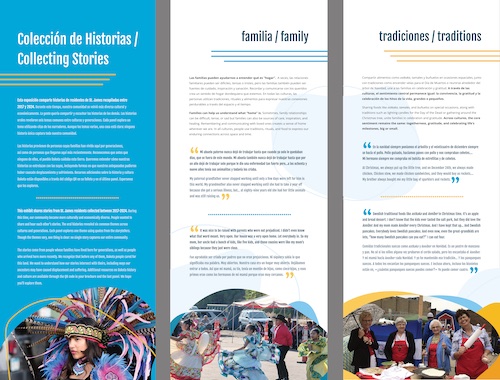Exhibit Design: Who We Are and How We Got Here
 The exhibit consists of a series of 8 retractable banners, including layout and editing of bilingual text for the “Who We Are and How We Got Here” oral history project in St. James.
The exhibit consists of a series of 8 retractable banners, including layout and editing of bilingual text for the “Who We Are and How We Got Here” oral history project in St. James.
Eight panels were designed and are ready to be sent to fabrication. The panels include an intro and outro to the exhibit and six panels, each with two quotes relating to one of the six cultural themes most frequently addressed in the collected narratives. Each panel is bilingual, intentionally designed to have the content displayed first in Spanish, followed by the English equivalent. The quotes also appear bilingually, with the quote in the speaker's first language followed by its translation.
The exhibit includes a QR code which will link to the collection of narratives in the UMN-Morris archives as well as to additional resources on the Uniting Cultures/Uniendo Culturas website (the webpage formatting for this is still being completed; currently the code links to Google Drive folders). A brochure is being created to accompany the exhibit; it will include a description of the overarching project, more details about the process for collecting the stories, and the QR code link to the narratives and supplemental resources.
Visit https://www.mnhs.org/about/leadership
Visit https://www.mnhs.org/preservation/legacy-grants/advisory-committee
$5,982,000 the first year and $7,000,000 the second year are for statewide historic and cultural grants to local, county, regional, or other historical or cultural organizations or for activities to preserve significant historic and cultural resources. Money must be distributed through a competitive grant process. The Minnesota Historical Society must administer the money using established grant mechanisms, with assistance from the advisory committee created under Laws 2009, chapter 172, article 4, section 2, subdivision 4, paragraph (b), item (ii).
Available upon request. Contact: grants@mnhs.org
Short Term/Engagement of the individuals whose stories are included:
Two focus group meetings were held with the interviewers and interviewees; more than 75% of those invited to participate attended those meetings.
Intermediate Term/Engagement of the broader community with the exhibit:
The fabricated exhibit will be "launched" on Sept 5 at a public event at the local library, as a kickoff to Welcoming Week. Its inaugural appearance will be at the Passport to the World tent at the community's Multicultural Fiesta on September 14, and will then be on display at the Watonwan County Library has the first stop as a touring exhibit. The Pioneer Bank, MCHS-St. James (Mayo Clinic site), and both the Northside Elementary and St. James High Schools will host the exhibit over the next months; other community institutions will be invited to host the exhibit as well; that exceeds our initial goal of at least 3 host sites. We anticiipate that far more than 25 community members will attend the launch exhibit, and the attendance at the Multicultural Fiesta typically exceeds 500.
Long Term Impact:
In measurable terms, this remains to be seen. However the appreciation of the ethnic and cultural diversity in the community, as well as a growing sense of belonging for those who previously felt unseen and unheard through sharing their stories is named anecdotally in this YouTube video in which Julieta and Ever, two of our cultural liaisons, share their thoughts about the project in this Youtube video: https://youtu.be/_8z6ZHjJ7mU?si=tu2wa-uctKrUfvAr
Available upon request, grants@mnhs.org
